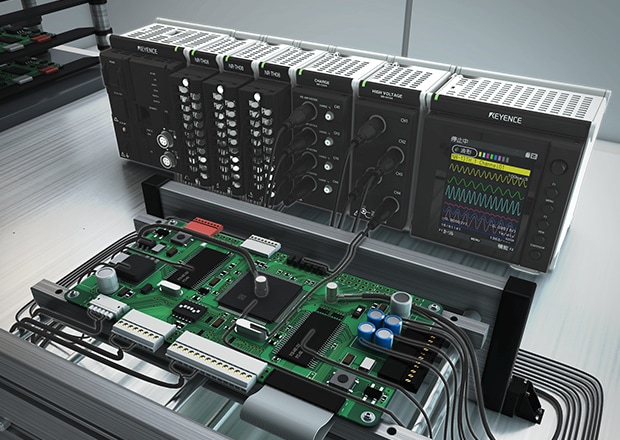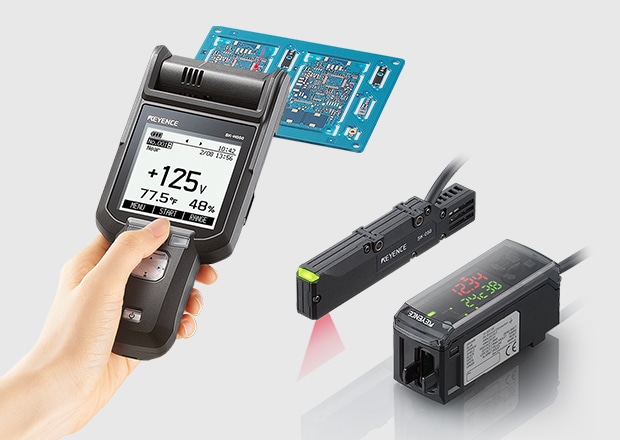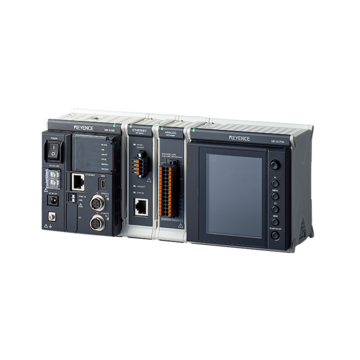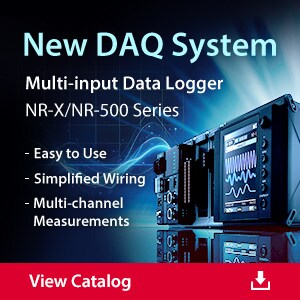Data Acquisition (DAQ)
Top ESD Measurement Challenges & How to Overcome Them
-
Tags:
- Voltage

Electrostatic discharge (ESD) measurement is essential for ensuring the quality of electronic components. It helps identify vulnerabilities to ESD events that can damage devices. However, engineers face challenges in conducting accurate ESD tests due to inconsistent ESD compliance, accuracy issues, and difficulty monitoring ESD in real time.
To address these challenges, KEYENCE data loggers provide accurate measurement and analysis of ESD events. This article explores key ESD challenges for engineers and how KEYENCE multi-input data logger solutions effectively address them.
Understanding the Importance of ESD Measurement
ESD is a major concern for electronic devices, as it can affect their reliability and safety. ESD happens when objects with different electrical charges touch or separate, causing a surge of electricity that can damage components. To protect against ESD, manufacturers must conduct thorough testing and follow standards, making ESD measurement a crucial part of product development.
ESD measurement is important for manufacturers to identify design flaws and enhance product performance and safety. By evaluating a device's ESD tolerance, they can assess resilience to electrostatic discharges and make improvements before market release. This is vital for meeting industry standards and regulations. Products must comply with various standards:
- EN 61000-4-2 for consumer electronics
- EN 60601-1-2 for medical devices
- ISO 10605 for automotive
- RTCA DO-160 for avionics
Accurately assessing ESD levels helps manufacturers meet essential standards for quality control and product certification, like CE marking in Europe and FCC certification in the U.S.
We’re here to provide you with more details.
Reach out today!

Common Challenges in ESD Measurement
Measuring ESD presents challenges that can hinder accurate assessment in specific environments or on electronic devices.
Inconsistent ESD Compliance Across Environments
Electronic equipment operates in various environments with different levels of ESD. Each setting—office spaces, industrial areas, urban locations, or remote sites—presents unique ESD conditions that can impact the performance and reliability of electronic products. The variation in ESD levels challenges manufacturers in achieving consistent compliance with ESD standards. Inconsistent compliance can harm product performance, increase safety risks, and damage critical electronic components.
- Lack of Standardized Testing
- A key reason for inconsistent ESD compliance across environments is the lack of standardized testing protocols. While international standards like IEC 61000-4-2 offer general guidelines, they don’t define specific test setups, leading to variations among manufacturers. Additionally, unclear calibration guidelines for ESD testing equipment can further result in inconsistent results.
- Varying Voltage Levels
- Compliance tests evaluate voltage levels ranging from 2 kV to 15 kV according to a product's environment, typically conducted in controlled laboratory settings. However, these conditions may not accurately represent real-world ESD levels, which could result in the introduction of non-compliant products that pose risks to both manufacturers and end-users.
- Environment Temperature & Humidity Changes
- Humidity, temperature changes, and human error can complicate ESD compliance. Low humidity can increase air conductivity, leading to higher ESD levels, while extreme temperatures can impact electronic component performance and durability against ESD events.
Accuracy Issues with ESD Measurement Devices
ESD measuring devices are designed to assess electrostatic charges on surfaces, safeguarding sensitive equipment and products from potential discharges. However, users have historically faced challenges with the accuracy of these instruments.
- Interference
- A key challenge with ESD measurement devices is their susceptibility to interference from nearby electronic equipment. In environments with many devices, isolating and accurately measuring electrostatic charges becomes increasingly difficult due to this interference.
- Human Error
- Additionally, the accuracy of ESD measurement devices can be impacted by human error. Inadequate wiring or improper setup may result in inaccurate readings, which can have serious implications in industries where precision is crucial.
- Different Types of Electrostatic Charges
- Beyond external factors and human error, a major challenge with ESD measurement devices is accurately assessing various types of electrostatic charges. Some devices are limited to specific charge types, while others may struggle to effectively detect low-level charges.
- New Materials
- As technology advances, traditional ESD measurement methods may become inadequate. New materials like conductive polymers and carbon nanotubes have unique electrostatic properties that conventional devices struggle to measure accurately.
Difficulty in Monitoring Electrostatic Discharge in Real-Time
ESD is the sudden flow of electricity between two charged objects initiated by factors like friction, contact, or atmospheric conditions, posing a significant risk to sensitive electronic components and potentially causing malfunctions and failures in devices such as computers and smartphones.
To mitigate potential damage, monitoring ESD levels in real-time during the manufacturing and operation of electronic devices is crucial. However, this task presents a significant challenge for many industries.
A notable challenge in real-time monitoring of ESD is the precise detection and measurement of the discharge. This complexity arises from the unpredictable nature of ESD, which can happen unexpectedly and without warning.

Traditional methods often require specialized equipment and extensive wiring. This adds to the cost and time involved in measurement and increases the risk of errors or incorrect readings due to human mistakes. Monitoring ESD is particularly challenging in environments with significant electromagnetic interference (EMI), like factories or labs with many active electronic devices. EMI can disrupt accurate measurements, making it harder to distinguish between background noise and actual ESD events, complicating real-time detection of ESD occurrences. One way to monitor ESD real time utilizes a handheld static meter or fixed mount static meter used with a data logger. For example, the KEYENCE SK Series Fixed Mount Static Meter data can be recorded with the NR-500 Data Logger in real time.
Get detailed information on our products by downloading our catalog.
View Catalog

Overcoming ESD Measurement Challenges
ESD poses a challenge in electronic device manufacturing, potentially damaging components and causing costly delays. Industries have implemented the following strategies to mitigate ESD risks:
- Proper Grounding Techniques: Ensure all equipment and personnel are adequately grounded to safely discharge static electricity.
- Minimize Noise Interference: To mitigate noise interference, companies shield sensitive equipment, reduce nearby electronic devices, or use filters to block unwanted signals.
- Utilize Specialized ESD Simulators: Specialized ESD simulators create varied conditions, allowing for more accurate assessments and better risk understanding.
- Carefully Select Test Points: Choose test points that accurately reflect component sensitivity and are accessible during production and design for efficient testing.
- Implement Continuous Monitoring: A continuous monitoring system tackles ESD measurement challenges by offering real-time data, enabling quick detection and protection of sensitive components.
- Train Personnel: Employees must be knowledgeable in handling procedures, grounding techniques, and using specialized tools to reduce ESD risk effectively.
The KEYENCE NR-X Series
Efforts have been made to create more accurate and reliable ESD measurement devices. For instance, the KEYENCE NR-X Series is designed for modern industries, providing user-friendly operation, compatibility with various applications, and an efficient wiring system for quick setup.
The NR-X Series includes a user-friendly setup function with intuitive icons, enhancing accessibility for first-time users. This design ensures accurate and efficient ESD measurements can be performed by anyone in the workforce without needing extensive knowledge or experience in ESD testing.
The NR-X Series goes beyond traditional AC or DC power supply units. It features a high-capacity lithium-ion battery that supports up to 800 minutes of data collection, allowing measurements from virtually any location without reliance on external power. Its wireless LAN unit also enables real-time remote data collection and monitoring, offering users greater flexibility and convenience.
Measuring ESD is crucial for the reliability of electronic devices across industries. The KEYENCE NR-X Series addresses the challenges of accurate ESD detection with advanced features and an intuitive design. This device enables businesses to monitor ESD effectively in real-time, protecting their equipment and ensuring uninterrupted operations.
Technological advancements have streamlined ESD measurement challenges, ensuring the optimal operation of electronic devices. With solid knowledge, thorough training, and reliable tools like the NR-X Series, businesses can effectively mitigate ESD risks and protect their investments.
Don’t let ESD compromise your operations—invest in a dependable solution like the NR-X Series today. Contact KEYENCE today.
Contact us to learn more about how our advanced technology can help take your business to the next level.
Contact Us


